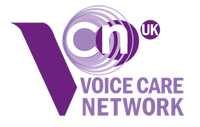download links: top tips for voice care wise warm ups
Your Voice
Your Voice is produced when your brain is stimulated. The cry at birth uses your voice for the first time. You listen to your parent’s voices as you grow up. You copy and repeat what you hear, gradually learning words and developing your way of speaking with the rhythms, intonation and pronunciation that you hear.
Just as a trumpet needs the power of the breath to create vibrations and the shape of the instrument to resonate the sounds.
For your voice -
- breath is the power for voice, the support and flow of breath from your lungs causes the vocal folds in your larynx (or voice box) to create vibrations
- the vibrations, or sound waves, resonate in the space of throat, mouth, nose (and to some extent your chest) and become your voice.
Your voice has a unique sound and people who hear it can recognize you.
You form the vowel sounds by shaping your mouth with tongue and lips
Vowel sounds help your voices to carry – as in “Hi! You!”
You make the consonants by constricting or shaping/holding the sound with your tongue, teeth and lips, as in the sounds “z” “b” “l” “m”.
The muscular energy of consonants gives clarity to words and to their meaning.
Voice at work
If you have to speak at work for long periods, in large spaces and to big groups the effort may put pressure on your voice and cause strain. If the strain is too great voice problems may develop and make the voice less effective, which will have less impact on the listeners. If the speaker is aware of this they can feel less in control and less confident.
Voice training is an opportunity to check the efficiency and the ease of the natural process. Understanding how your voice works and how to take care of it helps to gain control.
Practical steps to keeping your voice healthy
Voice is a part of the whole body’s muscular system. It is an advantage to have some form of exercise to keep your muscles flexible, and also learn ways to reduce tension, to stand and move with muscles in tone and easy postural alignment, especially of the head, neck and shoulders.
- The larynx works best when it is moist, like the inside of your mouth, so - drink plenty of water, daily, especially when working in a hot dry atmosphere. (you breathe through your mouth when you speak).
- Frequent or harsh throat-clearing is not good for the larynx, sip water and try to avoid this.
- Make sure you give your voice a rest at some time during the day.
- If your voice gets tired or hoarse, rest it. Use the steam from hot (not boiling) water, carefully breathe the steam, it can moisten your larynx.
- If you have a cold and you lose your voice – avoid whispering, reduce talking where possible, use steam (with care) delegate to others, take medication and rest your voice.
and, it continues for three weeks, it is advisable to check this with your GP.
If it continues for six weeks, the suggestion of speech and language therapists is that you seek specialist advice, via your GP, from an ear, nose and throat consultant.
“Fitness to Teach” DfES and DoH 2001 acknowledges:
- that teachers may experience voice disorders as a result of their work, and if this happens they should receive ENT assessment and speech and language therapy.
- that those who have voice training appear to have fewer voice problems during their careers than their peers.
Your voice is an individual matter. Minor adjustments to your lifestyle may provide the breakthrough you need for vocal health. A few minutes a day spent warming-up your voice will keep it fit and flexible. The greater art of oral communication may take a lifetime to perfect…


